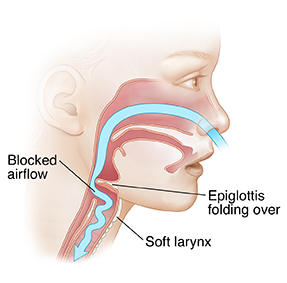When Your Child Has Laryngomalacia
When Your Child Has Laryngomalacia
Your child has laryngomalacia. This is a condition that causes your child to have noisy breathing. Although the breathing may be loud, your child is not choking. This condition usually goes away over time. Laryngomalacia may range from mild to very serious. About 20% of children with this condition also have other defects.
Normal |
Laryngomalacia |
What is laryngomalacia?
Laryngomalacia happens because the upper part of the voice box (larynx) is floppy or soft. Usually, the epiglottis from the front and 2 paired pieces of cartilage called the arytenoids from the back are involved in this intermittent closure. The job of the epiglottis is to help keep food from getting into the windpipe (trachea). When your child breathes in (inhales), the floppy epiglottis and arytenoids collapse. This causes your child to have noisy breathing.
What causes laryngomalacia?
It is not known why the condition happens in some children. What is known is that it’s not your fault or the fault of your healthcare provider.
What are the signs and symptoms of laryngomalacia?
Stridor is the high-pitched sound that’s made when your child breathes in. It is the most common symptom of laryngomalacia. Stridor may sound worse when your child is lying on his or her back or if he or she has a cold. It may also worsen as your child grows and becomes more active. This is normal. Stridor will stop as the condition goes away.
How is laryngomalacia diagnosed?
Your child’s healthcare provider will take a medical history and examine your child. The healthcare provider will likely refer you to an otolaryngologist, a healthcare provider who specializes in care of the ears, nose, and throat (ENT). In some cases, a laryngoscopy (a test that lets the ENT healthcare provider see inside the larynx) is also done. With a laryngoscopy, a thin, usually flexible scope is passed through the nose or mouth into the throat. It allows the ENT healthcare provider to look for problems with the epiglottis, larynx, and the area around the larynx.
How is laryngomalacia treated?
Your child's healthcare provider will closely watch your child. In most cases, the condition goes away without treatment. As your child grows and develops, the epiglottis will likely become stronger and no longer collapse during breathing. In some children with more serious laryngomalacia or who have other defects, surgery may be needed.
When to call your child's healthcare provider
Call your child's healthcare provider if your child:
Has worsening symptoms of laryngomalacia
Has trouble eating
Isn't gaining weight
When to seek emergency care
Call your healthcare provider right away or seek emergency care if your child:
Has trouble breathing
Turns blue in the face
Tips to reduce reflux
Babies with laryngomalacia may have trouble keeping food down. This means food often comes back up into the mouth (reflux). Follow any instructions the healthcare provider gives you to reduce your child’s reflux. The following precautions for feeding your child can help:
Hold your child in an upright position during feeding and at least 30 minutes after feeding. This helps keep food from coming back up.
Burp your child gently and often during feeding.
Avoid juices or foods that can upset your child’s stomach, like orange juice and oranges.
Talk to your child’s healthcare provider if food comes up a lot during feeding. You may be told to give your child less milk to avoid reflux.
Never lay your baby flat on his or her back with a propped bottle.
Updated:
March 02, 2018
Sources:
Congenital anomalies of the larynx. UpToDate
Reviewed By:
Holloway, Beth Greenblatt, RN, M.Ed.,Image reviewed by StayWell medical illustration team.,Kacker, Ashutosh, MD

